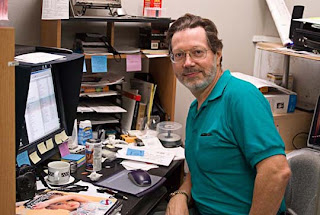But What do you DO?

I (this is Neil talking) get asked every once in a while what is it that I do here at the studio, besides use a camera. Like many other things, my duties changed quite a bit with the switch to digital.
I’ve always been the new information grunt of the studio, meaning that I am the unfortunate soul who is assigned to read about new or changed or re-discovered ideas or equipment that may be of use here in the studio.
In another essay, I noted that we used the same cameras for twenty-plus years. The biggest “workflow” change in one long period of years came when we switched film speed, or sensitivity to light, of our basic film. We had to re-test to establish the best quality exposure at what “speed” or ISO rating, and then adjust our hand-held light meters to that setting. It took about five days, mostly waiting for the film to be developed a couple times as we tested and re-tested.
Ah, the good old days.
Now, our “film” (i.e., camera) needs changing every couple of years or sooner, as the camera/sensor combinations that make a modern digital camera are improved enough that we need to “upgrade”. And the software tools we use are in constant flux (upgrades, improvements) and I have to be up on all of those. Oh, and then … there’s the NEW software ideas and programs that we need to be aware of.
Each time any kind of camera or software change happens, the “workflow” of how we process the images through our system changes, and often in quite-often-unforeseen ways. I’m the person who sorts through all the new cameras and decides which are worth all of the:
I’ve always been the new information grunt of the studio, meaning that I am the unfortunate soul who is assigned to read about new or changed or re-discovered ideas or equipment that may be of use here in the studio.
In another essay, I noted that we used the same cameras for twenty-plus years. The biggest “workflow” change in one long period of years came when we switched film speed, or sensitivity to light, of our basic film. We had to re-test to establish the best quality exposure at what “speed” or ISO rating, and then adjust our hand-held light meters to that setting. It took about five days, mostly waiting for the film to be developed a couple times as we tested and re-tested.
Ah, the good old days.
Now, our “film” (i.e., camera) needs changing every couple of years or sooner, as the camera/sensor combinations that make a modern digital camera are improved enough that we need to “upgrade”. And the software tools we use are in constant flux (upgrades, improvements) and I have to be up on all of those. Oh, and then … there’s the NEW software ideas and programs that we need to be aware of.
Each time any kind of camera or software change happens, the “workflow” of how we process the images through our system changes, and often in quite-often-unforeseen ways. I’m the person who sorts through all the new cameras and decides which are worth all of the:
* Money
* Time spent learning the new camera
Then, I have to determine its best file (image) handling processing steps. I test the camera out every way we might use it and master all the settings and features of all these complicated new professional units. I teach Miriam (and myself) how to use it, and then when we’ve got it down comfortably and repeatably, plan how to phase the new camera in and the old camera out.
Note, each camera’s images have their own best-practices procedures that are NOT well-stated by the manufacturer. So, I sit down and run images through all our standard workflow patterns, learning where we need to change from our current practices for best quality AND best “through-put”. I make a number of large and small prints from images, and we pore over them to see which techniques and practices worked best.
This takes us into the tools of our processes … the software.
I have other words that I often use in my own head in place of the term “software”. Software sounds … soft. You know, easy-going-gentle-small-brook-water-skipping-over-stones style soft. My other terms are more…realistic. And not repeatable in polite company. Or any company that I’d care to keep.
We use Photoshop, of course, and we use quite a number of other software programs for various purposes. I am the person who scours the web and consults with professional peers, looking for programs to watch. And study. If something looks perhaps useful, I test it on my own computer. Find out its real strengths and weaknesses, and whether it does something worth the interruption to our people and systems. Is it REALLY useful enough to merit the disruption and re-training that will be required? Then I figure out what changes need to occur in how and what we do in OTHER programs because of using the new one.
Then, of course, I train everyone here how to use the new program in (I always hope) a better workflow. This consumes hours and hours of my time every week, and is necessary to keep us where we always have been, at the top of our professional peers.
Since the advent of digital, we make up to six major workflow/software/hardware changes each year. Because for professional photographers, digital doesn’t mean “point and click”. To produce top quality art in the digital age, it takes time. And equipment. And software. There are still no shortcuts to quality.
But it keeps me out of trouble, and out of my staff’s way. Most of the time.



Comments